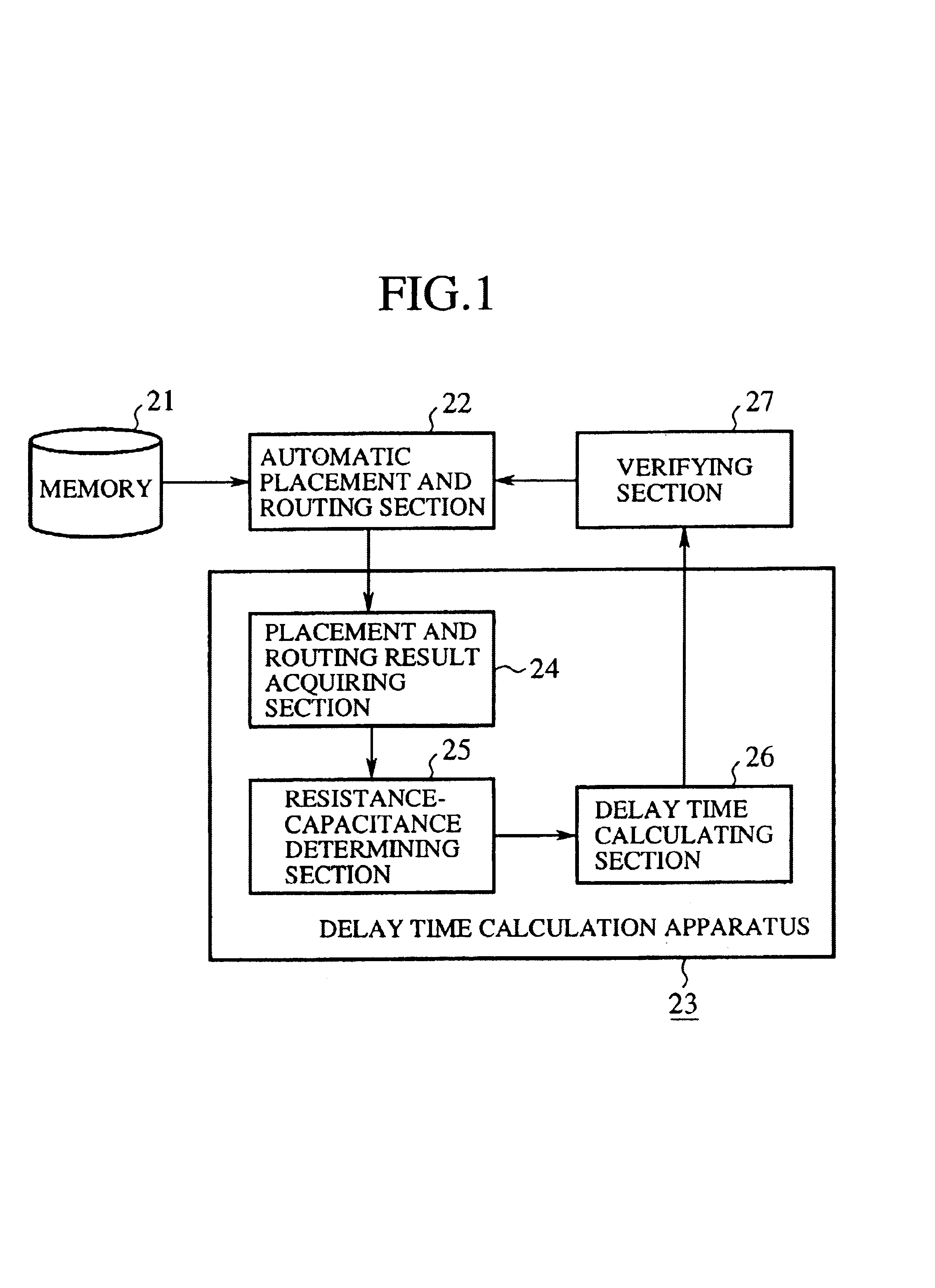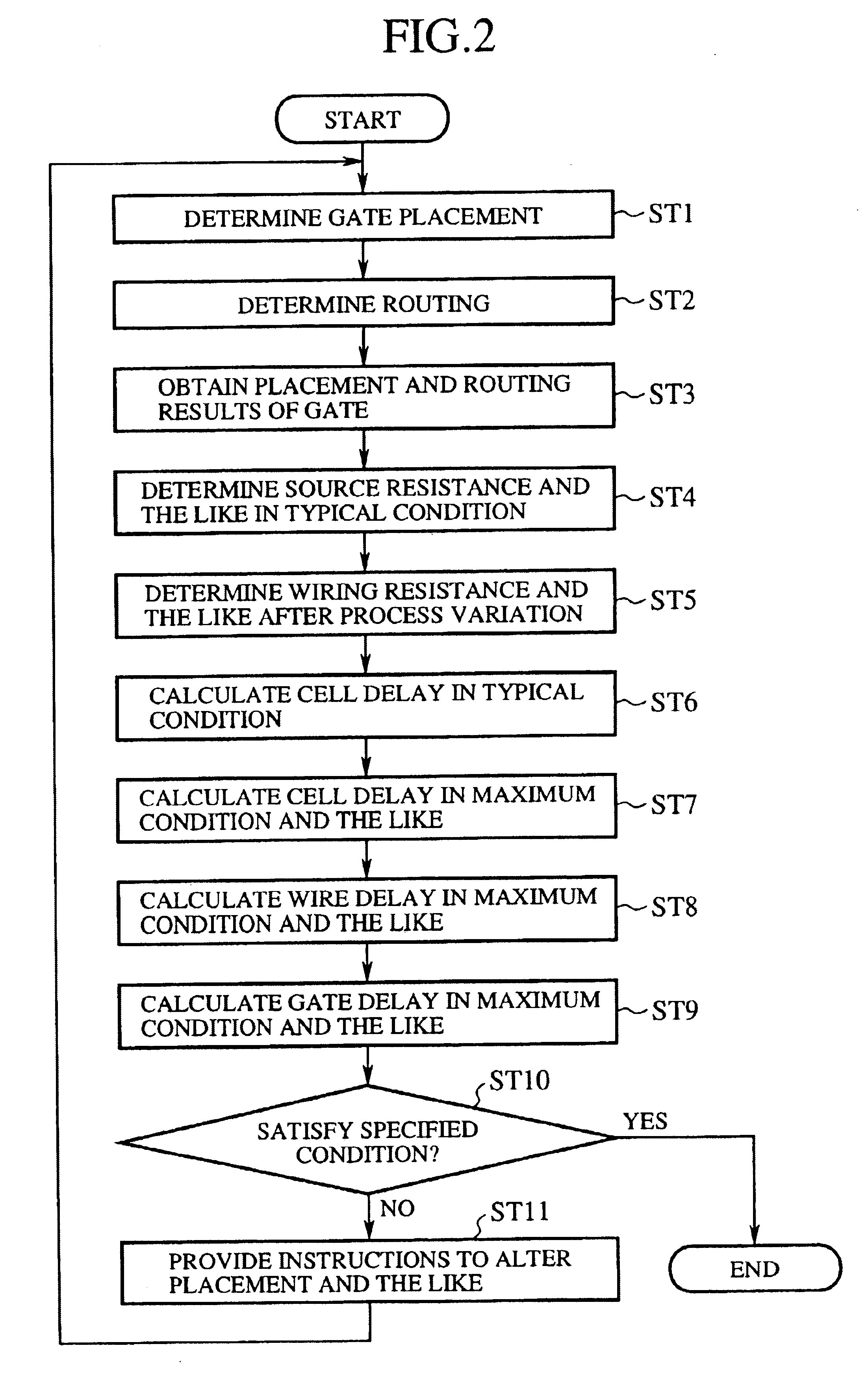Delay time calculation apparatus and integrated circuit design apparatus
a technology of delay time calculation and integrated circuit, which is applied in the field of delay time calculation apparatus and integrated circuit design apparatus, can solve the problem of not being able to calculate and achieve the effect of accurately calculating the delay time of the ga
- Summary
- Abstract
- Description
- Claims
- Application Information
AI Technical Summary
Benefits of technology
Problems solved by technology
Method used
Image
Examples
embodiment 1
[0054]FIG. 1 is a block diagram showing a configuration of an embodiment 1 of the integrated circuit design apparatus in accordance with the present invention. In FIG. 1, the reference numeral 21 designates a memory for storing placing conditions of a plurality of gates of the semiconductor integrated circuit and routing conditions between the gates; and 22 designates an automatic placement and routing section for placing the gates considering the placing conditions stored in the memory 21, and for routing between the gates considering the routing conditions. The reference numeral 23 designates a delay time calculation apparatus for calculating gate delay time after a process variation; and 24 designates a placement and routing result acquiring section for obtaining placement results of the gates and the routing results between the gates the automatic placement and routing section 22 generates.
[0055]The reference numeral 25 designates a resistance-capacitance determining section for...
embodiment 2
[0081]Although the foregoing embodiment 1 calculates the gate delays after the process variation, they can vary with temperature because the wiring resistance R(typ) varies with temperature.
[0082]In view of this, the gate delays after the process variation can be calculated as follows using the temperature variation coefficients KTWire(max) and KTWire(min) considering the temperature variations (see, FIGS. 4 and 5).
wire_delay(max)=FWire(Rs(typ), Cd(typ), C(max), R(max))×KTWire(max) (26)
wire_delay(min)=FWire(Rs(typ), Cd(typ), C(min), R(min))×KTWire(min) (27)
[0083]The temperature variation coefficients KTWire(max) and KTWire(min), however, are determined considering only the variations in the wiring resistance R(typ) under the assumption that all the cells of the semiconductor integrated circuit have the same source resistance Rs(typ) and diffusion capacitance Cd(typ). Accordingly, if the source resistance Rs(typ) and diffusion capacitance Cd(typ) of the cell to which the wire is co...
embodiment 3
[0089]The foregoing embodiments 1 and 2 calculate the cell delays cell_delay(max) and cell_delay(min) in the maximum and minimum conditions by multiplying the cell delays cell_delay(typ)′ and cell_delay(typ)″ in the typical condition by the process variation coefficients KPcell(max) and KPcell(min) for the cell delay. However, since the process variation coefficients KPcell(max) and KPcell(min) for the cell delay are values common to all the cells of the semiconductor integrated circuit rather than the values proper to the target cell for the delay time calculation, they can include large errors depending on the target cell for the delay time calculation.
[0090]In view of this, to achieve the calculation of the cell delays cell_delay(max) and cell_delay(min) in the maximum and minimum conditions without using the process variation coefficients KPcell(max) and KPcell(min), the present embodiment 3 has the resistance-capacitance determining section 25 determine the source resistances R...
PUM
 Login to View More
Login to View More Abstract
Description
Claims
Application Information
 Login to View More
Login to View More - R&D
- Intellectual Property
- Life Sciences
- Materials
- Tech Scout
- Unparalleled Data Quality
- Higher Quality Content
- 60% Fewer Hallucinations
Browse by: Latest US Patents, China's latest patents, Technical Efficacy Thesaurus, Application Domain, Technology Topic, Popular Technical Reports.
© 2025 PatSnap. All rights reserved.Legal|Privacy policy|Modern Slavery Act Transparency Statement|Sitemap|About US| Contact US: help@patsnap.com



